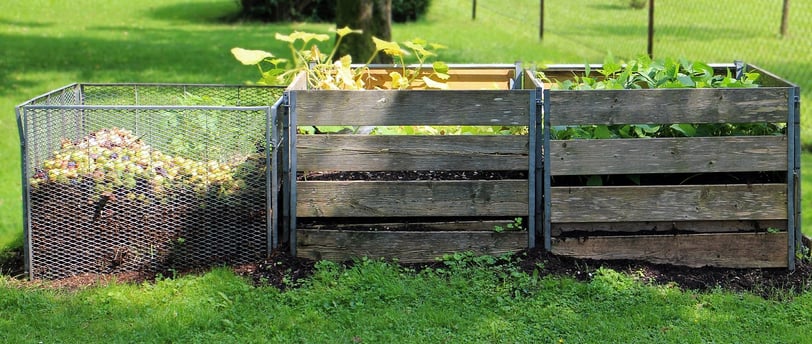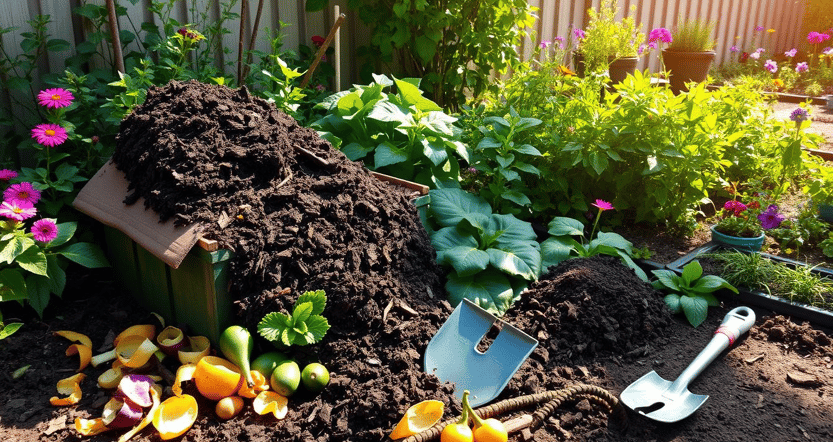Backyard Composting Made Easy: A Step-by-Step Guide to Start Today
Transform your kitchen scraps and yard waste into nutrient-rich compost with our easy-to-follow guide to backyard composting. Learn how to reduce landfill waste, enrich your garden soil, and lower your carbon footprint with simple steps. Whether you’re a seasoned gardener or a beginner, this post covers everything from what materials to compost, choosing the right bin, maintaining your pile, and the environmental benefits of composting. Get started today and create a greener, more sustainable future for your home and the planet! 🌱
GARDEN & RECIPES
11/24/20244 min read


Backyard Composting Made Easy: A Step-by-Step Guide to Start Today
Did you know over 30% of waste could be composted instead of going to landfills? Composting at home not only reduces landfill waste but also enriches your garden soil. This guide will show you how to turn kitchen scraps and yard waste into nutrient-rich compost, step by step. Whether you’re a seasoned gardener or just starting, backyard composting is easier than you think—and it’s great for the planet.
Why Compost?
Composting is a simple way to reduce waste and create something valuable for your garden. Here's why it matters:
Reduce Waste: Divert up to 30% of household waste from landfills.
Enrich Soil: Improve your garden's soil structure, fertility, and moisture retention.
Cut Carbon Emissions: Lower methane emissions by keeping organic waste out of landfills.
Save Money: Reduce the need for store-bought fertilizers.
By composting, you're taking a big step toward sustainable living and a greener planet.
Quick Start Guide: Composting Basics
If you’re short on time or just want the essentials, here’s how to start composting today:
Pick a Compost Bin: Choose a bin that fits your yard and lifestyle, such as tumblers for fast composting or stationary bins for larger capacity.
Choose a Spot: Place your bin in a semi-shaded, well-drained location that’s easy to access.
Layer Materials: Alternate “greens” (nitrogen-rich scraps like fruit peels) with “browns” (carbon-rich materials like dry leaves).
Turn Regularly: Aerate your pile weekly to speed up decomposition.
Monitor Moisture: Keep it damp—like a wrung-out sponge.
With just these five steps, you’ll be well on your way to creating rich, organic compost.
What Can Be Composted?
The golden rule of composting is to balance greens and browns for optimal decomposition:
Greens (Nitrogen-Rich): Examples include fruit and vegetable scraps, coffee grounds, grass clippings, and eggshells.
Browns (Carbon-Rich): Examples include dry leaves, straw, paper, cardboard, wood chips, and sawdust.
Avoid These Items:
Meat, dairy, and oily foods (they attract pests).
Pet waste or diseased plants.
Weeds with seeds that could regrow.
Choosing the Right Compost Bin
Your compost bin is the foundation of successful composting. Here are the most common types:
Tumblers: These bins are easy to turn and speed up composting, but they typically have smaller capacities and are more expensive.
Stationary Bins: Cost-effective with large capacity, but they require manual turning and compost more slowly.
DIY Bins: Customizable and budget-friendly, though their efficiency depends on the design.
Key Features to Consider:
Capacity: Choose a bin that can handle the amount of waste your household generates.
Material: Options include plastic, wood, and metal.
Ventilation: Look for a bin with good airflow for faster composting.
Design: Tumblers are ideal for speed, while stationary bins are great for simplicity.
Setting Up Your Compost Bin
Follow these steps to set up your compost bin effectively:
Choose a Location: Pick a semi-shaded, well-drained spot near your kitchen or garden for convenience.
Start with a Base Layer: Add coarse materials like twigs or straw to promote airflow and drainage.
Layer Your Materials: Alternate between greens (like food scraps) and browns (like leaves) to maintain balance.
Monitor Moisture and Airflow: Keep your pile damp and turn it weekly to allow oxygen to flow.
Pro Tip: A well-layered compost pile breaks down faster and prevents unpleasant odors.
Maintaining Your Compost Pile
To keep your compost pile healthy and active:
Turn Weekly: Mixing your pile lets oxygen in and speeds up decomposition.
Monitor Moisture: The pile should feel like a wrung-out sponge—neither too dry nor too wet.
Troubleshoot Problems:
Bad Smells: Add more browns and turn the pile to aerate.
Pests: Bury food scraps deep and avoid adding meat or dairy products.
Environmental Benefits of Composting
Composting has a significant impact on the environment:
Reduces Methane Emissions: Organic waste in landfills creates methane, a harmful greenhouse gas. Composting prevents this by keeping waste out of landfills.
Improves Soil Health: Compost enhances soil structure and fertility, reducing the need for chemical fertilizers.
Supports Ecosystems: A healthy compost pile encourages biodiversity, benefiting local wildlife and plants.
Did You Know?
According to the EPA, composting could eliminate up to 30% of the waste currently sent to landfills.
Harvesting and Using Finished Compost
You’ll know your compost is ready when it’s dark, crumbly, and smells earthy. Here’s how to use it:
Remove Large Pieces: Sift out any large, undecomposed items.
Spread a Thin Layer: Apply 1–2 inches of compost to garden beds.
Mix into Soil: Incorporate compost into the topsoil for best results.
Pro Tip: The best time to use compost is in spring and fall, giving your plants a nutrient boost during key growth periods.
FAQ
Q: What is backyard composting?
Backyard composting turns kitchen scraps and yard waste into nutrient-rich compost that improves soil health and reduces waste.
Q: What materials can I compost?
You can compost items like fruit peels, coffee grounds, grass clippings, dry leaves, and paper. Avoid meat, dairy, and oily foods.
Q: How do I maintain my compost pile?
Turn your pile weekly, keep it damp but not wet, and balance greens and browns.
Q: Can I compost in small spaces?
Yes! You can try vermicomposting (using worms) or Bokashi fermentation, which work well in small indoor spaces.
Conclusion
Starting a backyard composting journey is easier than you think. By choosing the right bin, layering materials, and maintaining your pile, you’ll create nutrient-rich compost that benefits your garden and the planet. Small steps like these make a big difference in reducing waste and living sustainably.
Ready to start? Grab your scraps, pick a spot, and get composting today!

